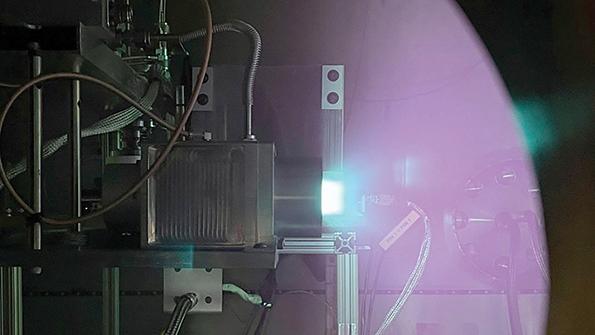
Vacuum chamber testing shows promising results for radio-frequency thrusters.
Phase Four says it has built and tested a next-generation radio-frequency thruster for spacecraft that equals the performance of a Hall-effect thruster.
The achievement, demonstrated over several weeks of testing in a vacuum chamber, is an important milestone in the Hawthorne, California-based company’s attempt to push the propulsion type into the mainstream of the small satellite industry.
- Radio-frequency thruster can use a variety of propellants
- Propulsion type might enable very-low-orbit spaceflight
“We’ve decided to develop a new technology in a conservative field—in aerospace—which is a hard thing to go into business for,” says Umair Siddiqui, Phase Four chief technology officer. “A lot of people say: ‘Oh, this technology will never work.’ The point of [this testing] is to basically prove to the world that, yes, a cathodeless thruster can meet or exceed these targets.”
The company’s next-generation radio-frequency (RF) thruster, the Maxwell Block 3, has shown performance using krypton propellant in the range of a typical Hall-effect thruster, Siddiqui says. Phase Four defines that comparable range as 250-800 watts of operating power, specific impulse of 600-1,300 sec. and thrust levels of 8-18 millinewtons. The company declines to give specific performance metrics but says it plans to post more detailed figures soon, when it anticipates exceeding the performance of a Hall-effect thruster.
A type of electric propulsion that has been used for decades for satellite orbital station-keeping and deep-space exploration, Hall-effect thrusters are a trusted technology among satellite operators. They ionize a propellant, such as xenon, to create an ionized plasma, which is then accelerated using an electric field to create thrust.
Phase Four says its radio-frequency system not only will have higher performance, but it will also be less expensive than a Hall-effect thruster—ideal for operators of low-Earth-orbit (LEO) constellations such as the U.S. Space Development Agency and OneWeb. The company’s thruster uses radio-frequency energy to heat a propellant into ionized plasma that is then ejected away from a spacecraft by a permanent magnet, creating thrust.
Phase Four has on orbit eight examples of its current product, the Maxwell radio-frequency thruster. Collectively, those have logged more than 5,000 days in space since 2021. Capella Space, an operator of satellite-based synthetic aperture radar, is one customer. Other customers have not been disclosed but tend to be “Earth-facing” LEO satellite operators, Siddiqui says. The thrusters were developed with small satellites weighing 110-1,100 lb. in mind.
Because a radio-frequency thruster system uses a permanent magnet instead of an electromagnet, as a typical Hall-effect thruster does, it is a simpler system, Phase Four says.
“There’s no cathode. There’s no heater. There’s no igniter. There’s no separate power supply for the anode and the cathode,” Siddiqui says. “There’s physically significantly fewer power electronics that go into the [power processing unit]. Our bill of materials is a lot simpler. The time to build is a lot [shorter]. All of those cascade and add up to a competitive price point.”
Phase Four says it has higher profit margins on its thrusters. Simplicity also means a 75% reduction in lead time, it says. The company’s new facility in Hawthorne should be able to produce 130 units per year. The first examples of the Maxwell Block 3 are anticipated to be ready for delivery in early 2024.
Because radio-frequency thrusters can be used with a variety of propellants—including xenon, krypton, iodine, water vapor, nitrogen and oxygen—Phase Four says the system could ingest propellant in situ.
“If you’re able to achieve high [specific impulse] with water vapor, then all of a sudden you can go to the Moon, mine water vapor and come back,” Siddiqui says. “Water vapor is abundant, especially in the outer Solar System, and so now suddenly you have natural gas stations.”
A radio-frequency thruster also could power spacecraft flying in very low Earth orbit (VLEO), a region roughly 125-186 mi. above the surface of Earth. There, atmospheric density creates friction and makes long-duration flight difficult for conventional spacecraft. However, a radio-frequency thruster could harvest gases from the atmosphere, such as nitrogen, oxygen and atomic oxygen, and then use them as propellant to stay aloft. Phase Four is designing a two-stage radio-frequency propulsion system for that purpose and is testing it using nitrogen in a vacuum chamber.
“It’s designed to resonantly accelerate gases of a certain molecular weight,” Siddiqui says. “Nitrogen, oxygen and even water vapor are roughly in the same mass range.”
The potential for VLEO spacecraft to carry electro-optical, infrared or radar sensors closer to a target has made the technology interesting to the U.S. Defense Department.
“There are a lot of intelligence applications,” Siddiqui says. “Whoever can get into the VLEO environment first has a national advantage over their peer adversaries.”





